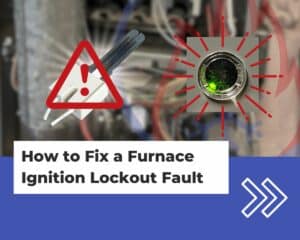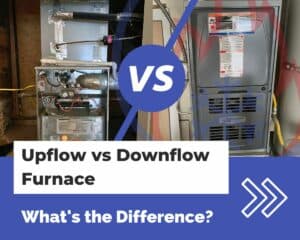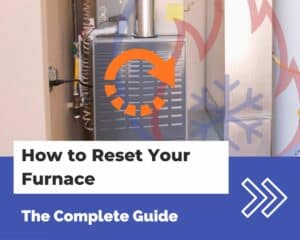HVAC Training Shop is reader-supported. As an Amazon Associate, I earn from qualifying purchases.
Most people think that only air conditioners have condensate. And while ACs do create a steady stream of water while running, some furnaces have condensate too.
The condensate drains out of the furnace’s drain lines. But problems arise when one of your furnace’s drain lines gets clogged.
A clogged drain line could be the reason why your furnace won’t turn on– especially if it’s a high-efficiency furnace.
In this article, I’ll tell you what you should do if your furnace’s drain line gets clogged.
I’ll also discuss what causes a drain line to get clogged in the first place– so you can prevent it from happening again!
How to unclog your furnace’s condensate drain
If there is water in your furnace or on the floor, then it’s almost always because the drain line is clogged.
To unclog your drain line, follow these steps:
- Check to see how bad the clog is. Take a look in your drain pan and outside where the drain line goes to see if it is something simple to fix. Sometimes, it will just be some minor blockage outside that needs to be cleared.
- Remove the clog by hand. If the clog is near the surface, poke your finger in the drain line to dislodge any debris and clear the clog.
- Use a drain brush or drain snake. You can use a drain flexible brush or snake up your line to unclog debris from the middle of your line. Using a drain brush will also scrub the inside walls of your drain line. This helps prevent clogs from re-forming in the future.
- Use a wet/dry vacuum. If you can’t unclog your drain line with a snake or brush, you’ll need to step it up a notch. Get a wet/dry vacuum to suck everything out. Attach the vacuum hose to the end of the drain line outside. You may need to seal the hose over the drain line, so no air escapes. Turn on the vacuum and suck any debris out. A wet/dry vac is usually strong enough to remove clogs from the middle of drain lines.
- Use a drain gun. If the wet/dry vacuum doesn’t work, then you need to bring out the big gun– use a drain gun to fire compressed gas into the line. The drain gun uses high-pressure gas to push out slime, dirt, and debris from the drain pipe.
How to use a drain snake to unclog your condensate line
Fortunately, there are easy off-the-shelf tools to help unclog condensate drain lines.
For example, the drain snake from your local hardware store is typically used to unclog sink and shower drains.
However, you can also use a drain snake to unclog your furnace’s drain line.
To use a drain snake on your condensate drain line, follow these steps:
- Turn off your furnace. Shut off the power switch or breaker so that your furnace is de-energized.
- Open the drain line access point. This is near the air handler. The access point is usually a cap on top of a PVC pipe tee that can be removed to access the interior of the drain line. Take note of any slime or debris inside the access point. If your drain line is sufficiently clogged, there will be standing water inside there as well.
- Use the drain snake on the line at the exterior of your home. Find where the drain line ends, typically outside of your home. Stick the drain snake up the pipe to clear any clogs and debris from the line.
- Use the drain snake in the line at the access point. Go to the access point and use the drain snake on that end as well. Sometimes, slime and debris can build up right near the furnace, so it’s important to clear out that end as well.
- Test the drain line. Pour a bit of water down the drain line to ensure that all of the clogs are removed.
- Put everything back together. After the clogs are removed, replace the access point cap and turn the furnace back on.
Why does a drain line get clogged in the first place?
A furnace drain line gets clogged due to one of three things:
- Debris stuck in the drain line
- Slime/algae growth in the drain line
- Restriction at the outlet of the drain line
Debris in your drain line comes from dirt and sediment inside your furnace. This happens especially to older furnaces that have some rust or dirty coils.
The best way to prevent debris from accumulating in your drain line is to conduct regular maintenance on your furnace. Change the filter and clean the coils regularly.
Another reason for a clogged drain line is slime growth.
The white slime found in your drain lines and drain pan consists of a colony of bacteria and algae.
The colony consumes dust and dirt in condensate, creating a white slime-like substance that sticks to the moist surfaces of your furnace.
In the worst cases, slime can even form on your coils.
The good news is that there are chemical treatment tablets that you can leave in your drain pan to inhibit slime growth. Just drop a tablet in every month, and you won’t need to worry about nasty slime clogging your drain line.
The last reason why a drain line might be clogged is due to a blockage at the outlet.
Leaves, rocks, and even small critters can get stuck and restrict flow at the outlet of your drain line.
The best way to keep things out of your drain line is to make sure that the outlet is clear of any plant growth. Check your drain line outlet every so often, such as whenever you do yard work.
What is a float switch for?
If a drain pipe becomes clogged, water will build up in the bottom of the furnace. Once there is too much water, a float switch will trigger the furnace to turn off.
While some people think it’s a nuisance, the float switch is a critical component of your furnace.
The float switch prevents your furnace from flooding your home with water. It does this by shutting off the furnace if an excessive amount of water is detected.
As water builds up in your furnace, the float switch floats upward and gets triggered. The float switch will shut off your furnace, preventing it from overflowing with water.
Why does a high-efficiency furnace make condensate?
High-efficiency furnaces create condensate because they have two super-efficient heat exchangers.
Gas is burned in the furnace and reacts with oxygen. The byproducts are flue gases and water vapor.
Large amounts of heat are absorbed from the flue gases. As the flue gases rapidly cool, water vapor condenses into liquid.
The condensate drains out through a pipe, usually on the bottom of the furnace.
Most high-efficiency furnaces also have a secondary drain line from the flue pipe. This secondary line is used to drain any residual moisture so it doesn’t leak into your furnace.




Nice work and thanks Trey. Helped me out with a clogged drain line for a gas furnace. And yes, I was one of those who didn’t realize a furnace had condensate.